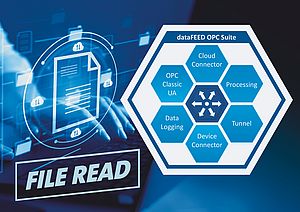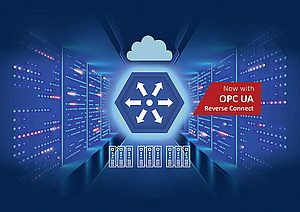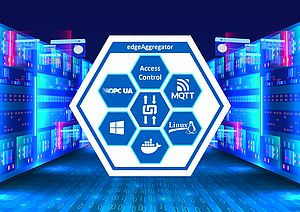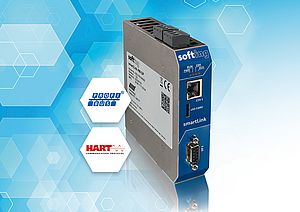“Let the data do the work” is one of the core messages from the 2024 Hannover Messe – one of the world’s biggest and most influential industrial trade shows. Applying this slogan to process automation (PA) raises the question of how hundreds or even thousands of parameters from complex field devices can be communicated to the right places. And how can these data “do the work” for us?
There’s plenty of potential: data from PA systems can be interpreted – either by experienced specialists or, looking to the future, with artificial intelligence (AI) – and used as input for decisions about optimization. These might involve process modifications to make production more energy- or resource-efficient, or interventions to optimize product quality. Plant availability can also be increased by means of predictive maintenance (PM). By combining data models with probabilities, devices can be replaced proactively rather than relying on reactive troubleshooting.
The status quo isn’t fit for purpose
Even as we admire the vision of optimized production based on effective data collection right into the field, we naturally need to review the current situation in process manufacturing. And even today, the vast majority of process systems are built along analog 4–20 mA lines. Digital inroads here were first made in the 1990s with the HART protocol, which overlays the analog power signal. Supplementing analog signal processing, this made digital communication possible at speeds of 1.2 kB/s. This was followed by the first digital fieldbuses with intrinsic safety, such as PROFIBUS PA and FOUNDATION Fieldbus (FF), which multiplied theoretical throughput to and from the field device to 31.2 kB/s.
Speeds are still very much limited even with fieldbuses, however. Network gateways (e.g. PROFINET to PROFIBUS PA) also require the use of a proxy, which itself multiplies the effort required for device integration, installation and maintenance. Last but by no means least, initial concerns are now emerging about the long-term availability of current field bus devices. With PROFIBUS PA still lacking sufficient market penetration, for example, Ethernet-APL is now being seen as its logical and more promising successor.
Maximizing performance with tech stack integration
Ethernet-APL has been specially developed for the process automation market, with a strong focus on the intrinsically safe supply of power to devices in Ex zones and at transmission speeds of 10 MB/s. Aside from transmission speeds alone, Ethernet-APL makes things much more streamlined by allowing communication to be handled solely via level 2 Ethernet-APL switches from the field device to the application without requiring additional gateways. This principle of seamless communication has been lacking with digital fieldbuses to date. With these fieldbuses, the proxy functionality described above will still be needed as a migration pathway for the transition to Ethernet-APL, however, one example being brownfield applications that use PROFIBUS PA.
This proxy functionality has been integrated into the aplSwitch Field PA from Softing Industrial, which has drawn on its long-standing expertise in gateways to achieve this implementation. In the case of the pnGate PA, for example, the proxy functionality that interfaces PROFINET with PROFIBUS PA is a proven solution that has now been adapted for use in the aplSwitch Field PA product.
With the aplSwitch Field PA, users can now effortlessly combine PROFIBUS PA and Ethernet-APL field devices in the network. This becomes important if the APL devices needed to ensure full plant functionality are not yet available or in cases where existing PROFIBUS-PA infrastructure is planned to be reused. For Ethernet-APL-only connectivity without PROFIBUS PA, the aplSwitch Field is also available without proxy functionality.
As mentioned above, the physical properties of Ethernet-APL provide the necessary foundation. The comprehensive integration of the entire tech stack – such as support for higher-level protocols like PROFINET and Ethernet/IP as well as FDI compatibility – is necessary, however, to fully exploit the full spectrum of benefits offered by Ethernet-APL:
- Quick installation and parameter setting
- Comprehensive diagnostic options
- Rapid response to unforeseeable events
- Reliable and automated logging
- Simple field device swap-out
- Easy access to all field device data
- Long-term equipment availability
As an expert for PROFINET and communications technologies, Softing has spent many years building up a comprehensive skillset in this area of the tech stack.
Why the time is right for moving to Ethernet-APL
For any new technology, its success depends on devices and infrastructure components being available in sufficient quantities – and ideally, from multiple manufacturers. In 2024, this turning point has now been reached for Ethernet-APL, as has been confirmed by surveys of infrastructure component and field device makers. In recent years, plugfests and conformity testing plus pilot projects with many end users have shown that the infrastructure and field device elements of various manufacturers work well together. Users can now choose from a broad range of products with second-source options and can also rely on component interoperability. In parallel, specific analyses of current use cases are also now underway with the aim of preparing realistic estimates of commercial benefits and so clearly setting out the added value that is offered by Ethernet-APL.
A foundation for efficiency gains and innovation
As a general rule, the ability to transmit relevant field device data at high speed to upstream applications or the cloud creates the basis that is needed for effective process plant optimizations. The large volume of available data plus lightning-fast communication between field and applications as far as the cloud creates new business models like predictive maintenance while laying the groundwork for new, AI-based learning models going forward. Ethernet-APL offers an outstanding basis to work with here. When combined with a tech stack, this charts a course to achieving measurable benefits for all process automation stakeholders, both now and in the future.
Author: Christoph Adam, Head Of Product Management Munich, Softing Industrial Automation GmbH



























